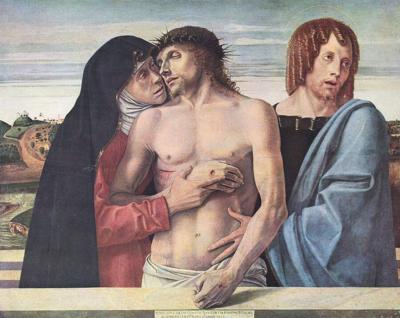Giovanni Bellini established a Venetian school of painting and as a painter himself; he has substantial knowledge about Renaissance art. His style in painting was derived from realism; he pursued subjects that gave rich amounts of meaning and message defined with emphasis in color and form. Giovanni Bellini started his humble beginnings in Venice, Italy, where he inherited his painting skills from his father who was once a painter of the 15th century Gothic revival artists. He was also inspired by a family member, his impressive brother in law Andrea Mantegna, who influenced him a lot when he started the first phase of his painting career and gradually learned to develop his own painting styles. His technique focused on softer shapes and an oozing poetic aura. From then on, Bellini started to master his skills by making pieces of art with religious and humanity themes.
Bellini is considered to be one of the leading portrait painters of the Venetian Renaissance because of his unique way of creating his masterpieces. His compositions in his paintings are superb in a way that they exuded serene self-sufficiency of values in his paintings. His techniques are composed in sculpturesque form, giving well defined contour lines with deep eloquence and great impact on compositional philosophy.
His Pieta Painting is made in oil canvas. The picture itself connotes a religious theme; it is evident in this picture that Jesus is supported by his mother The Virgin Mary and St. John. The composition is perfectly toned in colors, giving emphasis on the main theme and the atmospheric shades of tones supplied serenity and charm. This is yet another of his revolutionary paintings that is composed in rich tints with perfectly detailed intricacies of shades. The coloring is eloquent and fluent which gave a great effect on the whole portrait. The Pieta Painting shows grieving mourners of Jesus who is in agony. In its biblical theme, it somehow made the piece as timeless, classical, and poignant. The characters of the painting conveyed strong emotions that definitely reach out to its the viewers; Virgin Mary looks into the eyes of his dying son Jesus Christ, exerting painful effort to support his son. There is a sorrowful pain in her eyes as she closely looks and witnesses his son’s agony. The scene alone with Virgin Mary and Jesus Christ is deeply moving; there is a feeling of hope that his son could still be alive and escape death. The wounds can be seen on each hand of Jesus Christ because of the crucifixion, with his fingers curled in pain. On the right, St. John the Evangelist is bursting in sorrow and devastation; looking away from Mary because of the unbearable scene between a mother and a child both suffering from anguish and pain.
The three characters are consoled closely. In the foreground the scene is drawn in infinite perspective; the sky is painted in grey blue which conveyed an emotion of indifference and highlights torment and devastation of the characters. Certainly, the composition of colors and intricate details made the painting moving and agonizing. This is truly a kind of painting that will forever be considered as a timeless, biblical piece.
Author: Shyxter
